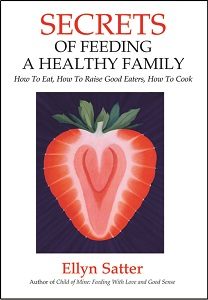

Family Meals Focus
The Ellyn Satter Institute Newsletter
Counterfeit permission
by Ellyn Satter, Registered Dietitian and Family Therapist
If a message or tactic encourages you to eat less, to avoid foods you enjoy, or to lose weight, it is controlling and therefore negative. The Satter Eating Competence Model, (ecSatter) is built on trust: Trust in you to take good care of yourself with food, to eat what you need and to eat as much as you need. Underlying it all is trust in your body to weigh what it will in response to your positive habits. While people with high eating competence tend to weigh less and eat more than the population average, ecSatter lays out no stipulations about what you should weigh. Your weight is what it is.
Food-management schemes are restriction in disguise
More and more of us are catching on that food restriction and striving for weight loss do more harm than good. Adults who try to manage their weight through restriction, deprivation, and good-food-bad-food thinking discover that such tactics worsen a weight problem. People in the weight-loss business, both health care and commercial, have picked up on consumer skepticism and reluctance to engage in weight-reduction dieting and advertise that they don’t give diets. What they do give is a food plan or a point system or a plate or pre-portioned food or some other scheme that stipulates what and how much to eat. This is not a diet? Of course it is! These seemingly ”permission-giving” food-management schemes conceal the ulterior motive of food restriction. They are counterfeits.
Control backfires
If a message or tactic encourages you to eat less, avoid foods you enjoy, or lose weight, it is controlling and therefore negative.
Control tactics may trick your head, but they don’t trick your body. In the long run, control tactics make you eat more and gain weight. To help you detect the difference between permission-giving and controlling tactics, I have excerpted this table from the 2008 edition of Secrets of Feeding a Healthy Family.
| Trust Message | Control Message |
| Go to table hungry but not famished. | Fill up by drinking water before a meal. |
| Eat until you feel satisfied. | Stop eating before you get full. |
| You decide how much to put on your plate. | Pay attention to portion size. |
| To be sure everyone will have enough, make enough to have leftovers. | Eat off smaller plates. |
| Savor sweets; eat until you get enough. | Eat sweets in small amounts. |
| ”C” is for cookie. | Cookies are a sometime food. |
| Non-verbal permission. Child’s eating is intuitive based on sensations, not thinking. | Are you done? Does your tummy say you want more? What does your tummy say? Slow down! |
| Go to some trouble to get foods you enjoy. | Don’t keep sweet foods at home. |
| Make eating important by taking time to enjoy meals. | Every time you eat a meal, sit down and chew slowly. |
| Pay attention to how good the food tastes. | Chew every bite carefully. |
| If you savor cheese and chocolate, you will get enough. | Cut cheese and chocolate into small pieces and only eat a few pieces. |
| Trust your hunger, appetite, and satiety to guide you at buffets. | Skip buffets. |
| Eat as much as you are hungry for. | Don’t have seconds. If you do, wait 20 minutes first. |
| Eat as much as you are hungry for. | Serve food portions no larger than your fist. |
Explore
To discover a kinder, gentler way to eat well and be healthy, read part 1, “How to eat,” in Ellyn Satter’s Secrets of Feeding a Healthy Family.
Related issues of Family Meals Focus
- Advice for an undergraduate dietitian: Practicing ecSatter
- Are you tired of feeling bad about your eating?
- Control vs trust in nutrition education
- Eating competence
- Eating competence and nutrition facts labels
- Eat what you like and be healthy!

